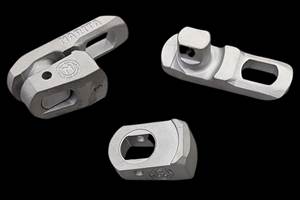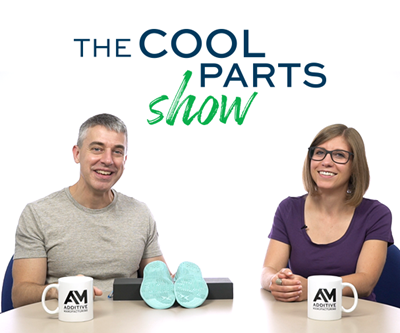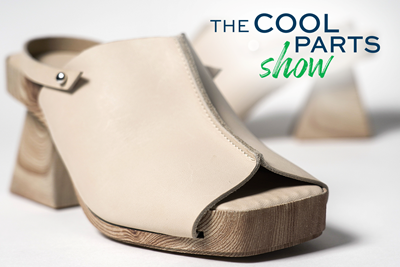An X-Ray View of Lattices and String Lasting: The Cool Parts Show Bonus
One recent cool part concealed most of its complexity. Take a look inside in this bonus episode.
Share
In the most recent episode of The Cool Parts Show, Pete Zelinski and I discussed a pair of shoes manufactured by Hilos. These custom heels combine a traditional leather upper with a 3D printed TPU platform that replaces multiple layers of material with just one piece. Lattices in the footbed provide the cushioning in place of foam, and internal channels accommodate the “string lasting” mechanism that unites all the parts of the shoe. But most of this complexity is invisible from the outside. To get a better look, we sent the shoes to Creative Electron, a provider of X-ray systems and inspection software. See what they found in this special bonus update. | This episode of The Cool Parts Show brought to you by Carpenter Additive
The Cool Parts Show is a video series from Additive Manufacturing Media that explores the what, how and why of unusual 3D printed parts. Watch more here.
Have a cool part to share? Email us.
Related Resources
- Our full episode of The Cool Parts Show on Hilos
- More on Hilos’ vision for sustainable footwear
- Creative Electron
Transcript
Peter Zelinski
I'm Pete.
Stephanie Hendrixson
I'm Stephanie. And this is a special update to The Cool Parts Show. So Pete, we just recently did an episode about Hilos, the custom recyclable heels with the 3D printed platform. Could you maybe just recap some of the high points there?
Peter Zelinski
Sure. Hilos, women's shoes, 3D printed, a couple things going on. One is lattices inside the structure of the lower part of the shoe. The lattices mechanically provide the cushioning, so there doesn't have to be padding, that's part of an assembly. So that lower part is just one piece 3D printed. And then the upper part is leather, like you'd expect, but the 3D printing helps there too, because passages inside that lower part, allow the upper to be held on with strings. String lasting was their term for it. No glue means it's easy to disassemble. Meaning when the wearers are done with the shoe, they send it back to Hilos, Hilos takes it apart, all those materials can be reused.
Stephanie Hendrixson
Right. And so we had the shoes here in the studio with us, we talked about a lot of those things. But a lot of the really interesting design elements, the lattice and the string lasting, were on the inside. Things that we couldn't actually see while we had the shoes here in the studio. Would you like to see what the inside of those shoes looks like?
Peter Zelinski
So do we have X-ray footage?
Stephanie Hendrixson
We have X-ray footage!
Peter Zelinski
I want to see.
Stephanie Hendrixson
So I sent the shoes out to Creative Electron. They're a company in California that develops X-ray systems and software for inspection. They scanned the shoes for us. And they sent us back some video and some photos of what they found.
Peter Zelinski
Okay, so I can see the lattices on the inside the 3D printed forms, I can see the string lasting in there too, the string. Does that look the way you expected it to look?
Stephanie Hendrixson
No, it doesn't. So we talk all the time about how 3D printing enables all of this complexity and like you sort of get that out of the lattice there. But when I first learned about string lasting and 3D printing together, I was picturing like this zigzagging string like running all the way through the shoes. And the fact that it's just like this one, figure eight. It's so like startlingly simple.
Peter Zelinski
Right? So thank you for saying that. Like that's what I was expecting, too. We talk about 3D printing enabling internal complexity all the time, and I expected some kind of complex thing and it's just that figure-eight bolo tie. It is a simpler and more elegant design than I had thought.
Stephanie Hendrixson
Yeah. And so it's a functional design. It lets the shoe do what it needs to do. It also makes that disassembly process, that recycling process much easier. So thank you again to Creative Electron for doing the scan, providing this footage and to Hilos for sharing the shoes with us. We'll see you next time on The Cool Parts Show.
Related Content
3DEO Wins Design Excellence Awards
3DEO was recognized for outstanding applications of powder metallurgy.
Read More3D Printed Capo for Banjo Made With Binder Jetting not MIM: The Cool Parts Show #74
New market, no mold tooling needed: Additive manufacturing via binder jetting enables a maker of guitar capos to expand to serve banjo players as well.
Read MoreWhy Customization at Mass-Market Scale Is Finally Possible With 3D Printing
Printer speed and materials coupled with scanning technologies are contributing to more affordable and accessible 3D printed, personalized goods.
Read More3D Systems Offers MJP 300W Printer, Wax Material for Advanced Jewelry Additive Manufacturing
The combination of the MJP 300W jewelry printer and VisiJet Wax Jewel Ruby enables jewelry designers to more efficiently achieve new designs with greater design freedom and improved surface finish.
Read MoreRead Next
Shoe Insoles Precisely Tailored to Individual Feet: The Cool Parts Show #4
This episode of The Cool Parts Show looks at how 3D printing will deliver tailored products. Scanning feet for their geometry and pressure enables Aetrex and EOS to manufacture insoles that are unique to individual wearers.
Read MoreCustomizable, Recyclable Shoes with 3D Printed Platform: The Cool Parts Show #37
A 3D printed TPU platform is the key to both comfort and sustainability for these custom heels manufactured on demand.
Read MoreCustom Heels Are a Step Up for Circular Fashion, Sustainable Manufacturing
Custom shoe company Hilos demonstrates how, with additive manufacturing, relative outsiders can not only launch a product, but implement a new production mindset into an established industry. The company is bringing comfort and customization to fashion footwear with sustainable, on-demand production based on 3D printing.
Read More
.jpg;width=70;height=70;mode=crop)














